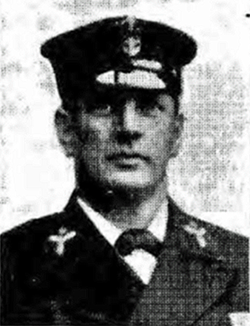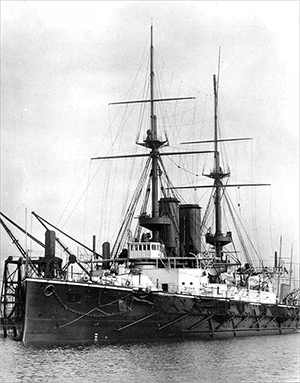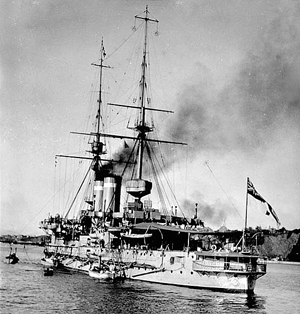First World War Project
Henry BURLEY (of Luddenham)
b. 5th December 1870 - Battersea, London; Petty Officer, Chief Stoker, Service Number 276014 (PO) |

"THE SOULS OF THE RIGHTEOUS ARE IN THE HAND OF GOD"
Henry Burley, a Londoner by birth and upbringing was a Portsmouth-based sailor. He found himself in Luddenham through circumstances that were entirely outside his control. Although he and his family were more naturally centred in Portsmouth, it is possible that his illness brought his wife (Rose, b. 1874) and their young daughter (Rose Louisa, b.11th September 1909) to be close to Henry. They lived in Four Oaks Cottages, Luddenham. Four Oaks Cottages sit on the Lower Road that runs alongside the railway linking Faversham and Teynham Stations. Teynham Station provided the spur to Sheerness Naval Base where Henry's ship, HMS Albemarle, sat at the time he died. Naval records tell us that before the ill-fated stop-over in Luddenham, Henry's young family lived at 34, Ranleigh Road, Twyford Avenue, Portsmouth (the naval port "HMS Victory"). After Henry died in Gillingham Hospital, the two Roses returned to their Portsmouth home. The official records of Henry's death give two different causes of death - influenza and enteric fever (typhoid) - "contracted on service".
The 1881 Census shows Henry's early life began in a large household at 14, Rashleigh Street, Clapham. His father, John, a boilermaker, and his mother, Louisa, a laundress. Clapham Junction Railway Station opened in 1863, to serve this growing suburb. So, engineers were in high demand in the area. Trams were also increasingly common in the urban expansion, giving Henry's oldest brother (Thomas, b. 1863) his occupation as a car-man.
By 1891, Henry is still in the family home (now 35 Pitcairne Street, Clapham), employed as a railway fireman with the London & Chatham Railway. His mother is now a widow and is the head of the household. Most of Henry's brothers and sisters had 'flown the coop'. His brother William, blind from birth, was a chair caner.
By 1901, Henry moved from the railways to become a "mechanical stoker" in the Royal Navy, boarding with another mechanical stoker in 10, King Street, Portsea, Portsmouth. Other records (De Ruvigny's Roll of Honour) give Henry's apparent 'joining date' as 1st January 1904, which conflicts in some measure with his 1901 Census return? De Ruvigny does contain errors, so it may be they are reporting the date of Henry's appointment as Petty Officer/Chief Stoker rather than his date of joining the Royal Navy.
Ten years later (1911 Census), Henry has started his own family living at 2, Seafield Road, Copnor, Portsmouth after marrying Rose (daughter of John Robertson) on 27th October 1904. Their first child, John Henry, was born on 14th December 1905 but died an infant (July-September 1907).
Henry served on HMS's Formidable (Mediterranean Fleet), King Edward (Atlantic Flag Ship), and Albemarle (Atlantic Fleet).
 |
_in_early_1907.png) |
 |
| H.M.S. Formidable (1898) | H.M.S. King Edward VII (1903) | H.M.S. Albemarle (1908) |
22nd January 1915 saw Henry succumbed to illness ("pneumonia" in the records of Gillingham New Graveyard), the CWGC Headstone Schedule shows that the inscription paid for by "Mrs R. Burney, Oaks Cottage, Luddenham, Faversham, Kent" appears on a cross and reads "THE SOULS OF THE RIGHTEOUS ARE IN THE HAND OF GOD". The location of Four Oaks Cottages gave Henry access to Sheerness and Rose access to Gillingham once Henry was admitted to the Naval Hospital and then buried.
Circumstances of the death of Petty Officer Chief Stoker Henry Burley
At the outbreak of war, Henry was serving on the HMS Albemarle, a pre-Dreadnaught (Duncan Class) battleship. Once the war was declared, HMS Albemarle and her sister ships were called into service by Admiral Sir John Jellicoe [Commander in Chief, Home Fleets], 8th August 1914, to join the 3rd Battle Squadron at Scapa Flow (Northern Patrol).
Quite when it was thereafter that Henry Burley first contracted his fatal illness cannot be determined. But there were ample opportunities to succumb to injury and illness during his service. For example, during a storm on the Firth on the night of 6th-7th November, the Albemarle "shipped two heavy seas which washed away her fore bridge, with everyone on it, and even displaced the roof of the conning tower; hundreds of tons of water flooded the decks and poured down below. An officer and one man were washed overboard and drowned, and several men injured." [Admiral Jellicoe's account] The injured ship would have depended heavily on the efficient operation of the engine room to make headway and for pumping under the extraordinary conditions of having harmful salt water pouring down through the decks, flushing with it oil and waste of all descriptions. Apparently, in daylight, the ship was in a very sorry state and had to be substantially refitted.
In response to increased German Navy (in particular, submarine) activity in the Channel Fleet Area, all five Duncan Class ships were transferred to the Channel Fleet, now the 6th Battle Squadron. Other ships being distributed northwards.
"On [November 12th] the new plan for meeting any attempt of the Germans to land troops upon our coasts had been completed. Its base idea was that whether the enemy's expeditionary force appeared north or south of Flamborough Head, we should be in a position to strike immediately at its covering force, in order either to break through and attack the transports and their escort, or enable the flotillas to deal with them.....In the southern area the idea of the plan was more difficult to realise effectively. Here there was little available, noting indeed by the comparatively old and slow 5th Battle Squadron and the still older "Duncans." Moreover, the only possible base was Sheerness, a port which did not admit of egress at all states of the tide or of indispensable fleet exercises. This was a specially serious drawback, because under the original War Orders the Channel Fleet was regarded as a reserve, and men were being continually drafted from it, so that it always contained a large proportion of untrained ratings. .... Still the position had to be occupied, and there was nothing else..... On November 14, therefore Admiral Burney left Portland with the 5th Battle Squadron for Sheerness and the "Duncans" for Dover."
Lack of submarine defences at Dover (after the boom had been carried away during a gale on 8th November) meant that ships stationed at Dover were moved to Portland from 19th November. The critical state of affairs in the southern areas was made worse by the loss of HMS Bulwark on 26th November off Sheerness.
Throughout the period, there was a significant and wider naval reorganisation of Squadrons. The 6th Battle Squadron returned to Dover in December and then transferred to Sheerness to relieve the 5th Battle Squadron to guard against German coastal invasion.
In December, there were plans to bring naval support to land-based forces on the Belgian coast, taking advantage of British naval superiority. After the Chantilly Conference of 27th December, when this plan was agreed, everything hinged on the Belgian King's agreement to a unified command - while agreeing to the attack on Ostende to secure the British flank, the King rejected the proposed unified command. Early December saw submarine attacks in the Channel under control and supplies flowed across to the British and Allied forces. After a series of Fleet exercises, a submarine (U.24) operating out of Flanders attacked and sank HMS Formidable having shadowed the Fleet exercises until an opportunity arose to attack. All bets were off for operations based on assumptions about German naval effectiveness in the Channel as elsewhere. The original plan was shelved on 8th January 1915.
This leaves Henry Burley stationed in Sheerness. Perhaps taking part in sweeps of shipping lanes but not involved in Fleet exercises. With HMS Albemarle's operational station now sitting in Sheerness, it was natural that his wife and child should join him and find a cottage with easy access to Sheerness, via Teynham. There are no clues to how or when Henry fell ill.
Disease affecting soldiers
The principal diseases to affect BEF and Home-based soldiers between August 1914 and February 1915 were reported to the House of Commons. The figures give an insight into the 'bigger picture' but not at the level of detail that helps us decide if Henry died of pneumonia or enteric fever (typhoid fever):-
"DISEASE STATISTICS.
HC Debate - 15 February 1915 vol 69 c901W 901W
§ Mr ROWLANDS - asked the Under-Secretary for War the number of cases, and deaths, among the Expeditionary Force of measles, scarlet fever, typhus, and typhoid fever since the commencement of the War?
§ Mr WILLIAM THORNE - asked the number of cases of and deaths from the following diseases amongst British soldiers on the Continent of Europe and in the United Kingdom, respectively, since 1st August, 1914: typhus fever, enteric fever, cholera, small-pox, scarlet fever, diphtheria, measles, dysentery, pneumonia, and cerebrospinal meningitis?
§ Mr TENNANT - The following is a Return showing the number of cases and deaths amongst the Expeditionary Force and the British troops in the United Kingdom of certain diseases from 1st August 1914:—
| Typhus Fever | Typhoid Fever | Cholera | Small-Pox | Scarlet Fever | Diph-theria | Measles | Dysen-tery | Pneu-monia | Cerebro-Spinal Menin-gitis | ||
|---|---|---|---|---|---|---|---|---|---|---|---|
| a. Exped-itionary Force | Cases | 0 | 625 d. | 0 | * | 196 | * | 175 c. | * | * | * |
| Deaths | 0 | 49 d. | 0 | * | 4 | * | 2 c. | * | * | * | |
| b. British Troops in the United Kingdom | Cases | 0 | 262 | 0 | 1 | 1,379 | 783 | 1,045 | 215 | 1,508 | 62 |
| Deaths | 0 | 47 | 0 | 0 | 22 | 6 | 65 | 1 | 301 | 26 |
a. The figures in this class include cases and deaths up to 11th February, 1915.
b. The figures in this class include cases and deaths up to 31st January, 1915.
c. These figures include Indian troops: cases 5, deaths 0.
d. These figures include Indian troops: cases 25, deaths 4.
* Returns for these diseases are not at present available."
Key Documents:
Complete and important naval texts can be found on the excellent site - www.naval-history.net. Two texts in particular help shed light on the circumstances experienced by Henry Burley.
- HISTORY OF THE GREAT WAR - NAVAL OPERATIONS, Volume 2, December 1914 to Spring 1915 (Part 1 of 2) by Sir Julian S Corbett (Published by Longmans, Green, London 1921)
- The Grand Fleet, 1914-1916 - Admiral Viscount Jellicoe
The Burley Family WW1 Generation
Click on small image (below) to view the larger image.


 World War 1 Pages
World War 1 Pages